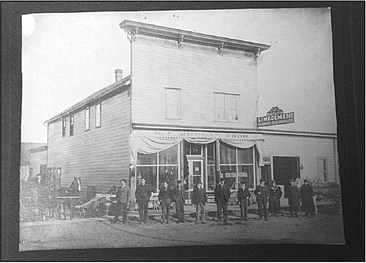typing up text descriptions, something ….


typing up text descriptions, something that took several months. During this time he’d often consult with Kuehling, picking his brain for additional information. And while this work was certainly labor intensive, the number of hours put into this part of the process paled when compared to time Gurtner spent collecting everything that went into the book.
This is the part that Gurtner enjoyed the most. The interviews, the time spent sitting down with people and going through pictures, talking about their lives. He’d show people what he had found so far, his binders of pictures and postcards, scribbling down notes as they’d ignite conversations about certain aspects of Unity and its people that he had not known. He speaks fondly of chats that began in the evening and continued through to the early morning.
“I spent a lot of time with a lot of people,” Gurtner said. “At the time, it didn’t mean anything except to me. I was just doing it because I wanted to. But later on it helped bind this whole book together.”
Because not only does the book capture the physical locations of what was where and when, but it also has the stories of the people who lived and worked amongst those buildings infused into it. The interviews Gurtner has done carry with them the history of the people he has spoken to and one can find the essence of those discussions within its pages. As mentioned earlier, many of the pictures were taken from old postcards. Many of these postcards contained personal messages, and while these messages often had nothing to do with the image on the front, Gurtner still liked to include something about the letter and the individuals sending or receiving it in that picture’s description.
“These postcards are worth their weight in gold,” Gurtner said. “You sometimes learn more on the backside than the front. It helps piece together the full picture.”
By putting all of this information into the book, Gurtner hopes that he can share what he’s learned about the village of Unity, both its buildings and its people, with others. His biggest regret with this project is that some of the people he got to know during his chats with them did not get to see the finished product.
“A lot of people I’ve interviewed have passed away over the last twenty years since I started this [project],” Gurtner said. “I feel bad that the people couldn’t see the final product, but their families and anyone else from now on will be able to see and read what they told me about themselves and the town.”
Despite a tight deadline, Gurtner was able to get the work done in time to have the book readily available for those at the reunion, so they would have an opportunity to read through it while they enjoyed the company of their fellow Unity alumni. He also has been working with several area locations, like the Colby Community Library and the Marathon County Historical Society, to hold his book as well, so that it can reach other audiences who might have an interest in Unity’s history.
His book may be published, but Gurtner says that his work is far from over. During his time collecting stories about Unity, he also has come across a lot of information about the neighboring Romeo and Riplinger areas and Leonhardt has a good bit of research done on Atwood and Longwood. Between himself, Leonhardt and Kuehling, he hopes to continue to learn more about those and other small communities around the area and there are plans to write at least one more book.
The history of small, rural communities can be preserved in books like Gurtner’s and he hopes that he can continue to expand his knowledge and share what he learns with others. If the gathering of Unity alumni shows anything, it’s that regardless of whether schools, churches, or stores still stand, the bonds of the people who once inhabited those places remain. Even if the buildings are gone, they still affect us now, and will continue to do so into the future.
